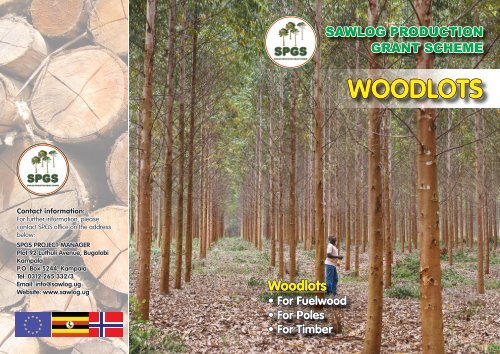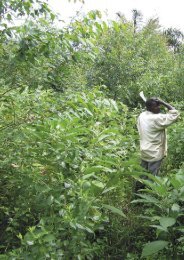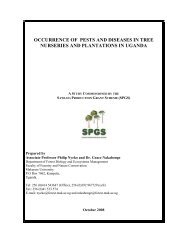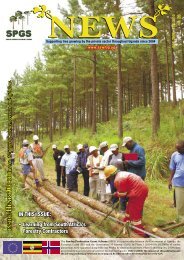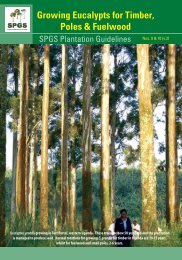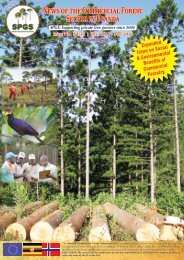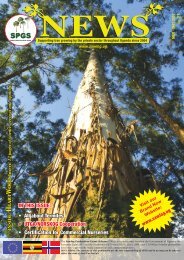You also want an ePaper? Increase the reach of your titles
YUMPU automatically turns print PDFs into web optimized ePapers that Google loves.
SAWLOG PRODUCTION<br />
GRANT SCHEME<br />
<strong>WOODLOTS</strong><br />
Contact information:<br />
For further information, please<br />
contact <strong>SPGS</strong> office on the address<br />
below:<br />
<strong>SPGS</strong> PROJECT MANAGER<br />
Plot 92 Luthuli Avenue, Bugolobi<br />
Kampala<br />
P.O. Box 5244, Kampala<br />
Tel: 0312 265 332/3<br />
Email: info@sawlog.ug<br />
Website: www.sawlog.ug<br />
Woodlots<br />
• For Fuelwood<br />
• For Poles<br />
• For Timber
<strong>SPGS</strong> WOODLOT SUPPORT<br />
1. What is <strong>SPGS</strong> Woodlot Support?<br />
This is an initiative that is aimed at supporting private<br />
and Government institutions that heavily depend on fuel<br />
wood energy to plant their own trees. The fact that over<br />
90% of Uganda’s population depends on fuel wood<br />
means that a lot of pressure is being placed on the few<br />
remaining natural forests. <strong>SPGS</strong> is targeting to support<br />
institutions to establish 1,000 ha of woodlots by 2013.<br />
2. Who are the target beneficiaries?<br />
All institutions or agencies which heavily<br />
depend on fuel wood as main source<br />
of energy may be supported as long as<br />
they meet minimum requirements. Target<br />
beneficiaries include; Churches, prisons,<br />
schools, army barracks, child care centres,<br />
rehabilitation centres, hotels, Community<br />
Based Organizations (CBOs), and<br />
community associations among others. Few<br />
individuals with strategic sites may also be<br />
considered. The target beneficiary should<br />
own land of between 5 ha to 25 ha which<br />
can be set aside for woodlots; and should<br />
have interest and capacity to maintain the<br />
plantation after it has been established.<br />
3. How does one apply for this<br />
support?<br />
Institutions or agencies that meet<br />
the above criteria can write a formal<br />
application letter to <strong>SPGS</strong> (see address<br />
on back page) giving a brief profile<br />
of their institution and attach a copy<br />
of their land ownership documents.<br />
Application should clearly indicate full<br />
contacts of the person or officer who<br />
will be responsible for woodlot.<br />
5. What are the proposed fuel wood tree<br />
species to meet objective?<br />
The tree species to plant depends on the<br />
site characteristics like soil and climate; and<br />
availability of good planting material. Some<br />
of the woodlot species so far planted include:<br />
Eucalyptus grandis (kalitunsi), Eucalyptus hybrid<br />
clones and Markhamia lutea (Musambya).<br />
Other tree species can be considered as long<br />
as they are suitable for fuel wood, plantable in<br />
a plantation form and the site is good.<br />
4. How does woodlot support work?<br />
Once an application is received and verified, <strong>SPGS</strong><br />
organizes a visit to assess the proposed planting site.<br />
After the site is approved, <strong>SPGS</strong> signs an agreement<br />
with applicant and forest contractor is sourced to work<br />
with the institution to establish woodlot according to<br />
<strong>SPGS</strong> standards. Upon certified completion of planting,<br />
<strong>SPGS</strong> hands over the woodlot to the beneficiary. The<br />
beneficiary is then required to maintain the woodlot<br />
according to <strong>SPGS</strong> standards as detailed in <strong>SPGS</strong>’s Tree<br />
Planting Guidelines for Uganda.


